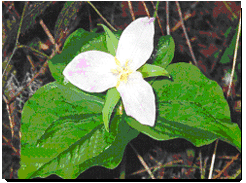Mima Mounds of Thurston County
A Study of Evapotranspiration,Geologic History
& Myths



The timing of each species of flowering plant makes the Mima Mounds Prairie a pleasing destination at different times of the spring and summer of each year. The first to show their "plumage" are the Camassia quamash (small camas), Dodecatheon hendersonii (mosquito bills or sailor-caps), Lomatium utriculatum (lomatium), and Ranunculus occidentalis (buttercup), with Zigadenus venenosus (grassy deathcamas) showing slightly later. An interesting side note is the fact that native Indians would harvest the edible small camas root in the early stages so as to distinguish them from the death camas root, which is quite toxic. Late spring and early summer produce flowering spotted cat's ear and St. Johnswort. By the end of summer most of the blossoms have died back and the Pteridium aquilinum (Champlain's brackenfern) dominates the green until it too turns dry and brown when fall sets in. All of these plants reside in different positions upon the topography of each mound and intermound area. The thin bentgrass, buttercups, St, Johnswort, spotted cat's ear, and Rhacomitrium moss grow in all areas, both in between and all over the mounds. Species preferring the intermound area include hair-cap moss, and Aira praecox (yellow hairgrass) as well as reindeer lichen. The bracken ferns tend to favor the north slopes and the Douglas fir saplings usually sprout on the crest of the mounds when given a chance to grow. Preservationist prefer to keep invading species at a minimum.
| Weekly Photos | Introduction | Methods | Results & Conclusion | USGS Map | History & Myths | HOME |